Jupiter is the fifth planet from the Sun and the largest planet of the Solar System. It is the oldest planet of the Solar System thus it was the first to take shape out of the remains of the solar nebula.
Keys Facts & Summary
- Since it is the fourth brightest object in the sky, Jupiter was observed since ancient times and thus no one can be credited for its discovery. However, the first telescopic observations were conducted by Galileo Galilei in 1609 and in 1610 Galileo also discovered the major moons of Jupiter, but of course not the smaller ones.
- Since many cultures observed Jupiter, they all gave it different names but the Roman name remained used in the majority of cultures. Jupiter is named after the principal Roman god, the equivalent of the Greek god Zeus.
- In ancient times, Mercury was taught as being two different objects in the sky: The Mourning Star and The Evening Star. In Venus’s case, it was also mistakenly believed to be two different things.
- Jupiter is one of the five visible planets (Mercury, Venus, Mars, Saturn), being the fifth most distant from the Sun at an average distance of 5.2 AU, its closest approach is at 4.9 AU and at its farthest 5.4 AU. Its exact position can be checked online since the planet is constantly tracked.
- It is the biggest planet of the Solar System, with a mean radius of 43.440 miles / 69.911 km, a diameter at the equator of about 88.846 mi / 142.984 km, and at the poles, the diameter is only 83.082 mi / 133.708 km.
- Jupiter is also twice as massive as all the other planets combined, having 318 times the mass of Earth.
Jupiter
Jupiter is the fourth brightest object in the sky, visible to the naked eye. It shines so brightly that even Venus dims in comparison. Because of this, it has been observed since ancient times by many different cultures. The discovery of Jupiter cannot be attributed to someone.

However, Galileo Galilei is the first astronomer to have observed Jupiter through his telescope. He began extensive observations of the planet in 1609. During this time and until 1610, Galileo discovered the four largest moons that orbit Jupiter: Io, Europa, Ganymede, and Callisto. They are called the Galilean moons in his honor.
He first thought of them as “fixed stars” but over time he witnessed that the objects changed positions, and he even almost correctly deduced their periods. This discovery was revolutionary since, at the time, most of Europe still endorsed the theory that all the planets orbited Earth.
Formation
Throughout the universe, there are many planetary systems similar to ours. Most of them contain terrestrial planets like our own and gas giants like Jupiter. However, they also contain super-Earths – planets that are several times more massive than Earth.
Distance, Size and Mass
It is the fifth most distant from the Sun with an average distance of about 5.2 AU. The closest approach is at 4.9 AU and at its farthest 5.4 AU. Its exact position can be checked online since the planet is constantly tracked.

It is the biggest planet of the Solar System, with a mean radius of 43.440 miles / 69.911 km. Almost 11 times bigger than Earth. Jupiter's radius is about 1/10 the radius of the Sun, and its mass is 0.001 times the mass of the Sun, so the densities of the two bodies are similar.
Orbit and Rotation
Jupiter rotates once every 10 hours – A Jovian day - thus it has the shortest day of all the planets in the solar system. A Jovian year, on the other hand, is about 12 Earth years, quite long in comparison to its short days. The orbital period is about two-fifths that of Saturn. The orbit of Jupiter is elliptical, inclined about 1.31 degrees when compared to Earth.

Picture of Planet Jupiter

Quick Facts
| First Record: | 7th or 8th Century BC |
| Surface Temperature: | -108°C |
| Orbit Period: | 4,332.82 Earth days |
| Orbit Distance: | 778,340,821 km (5.20 AU) |
| Notable Moons: | Io, Europa, Ganymede, & Callisto |
| Known Moons: | 67 |
| Equatorial Circumference: | 439,264 km |
| Polar Diameter: | 133,709 km |
| Equatorial Diameter: | 142,984 km |
| Mass: | 1,898,130,000,000,000,000 billion kg |











